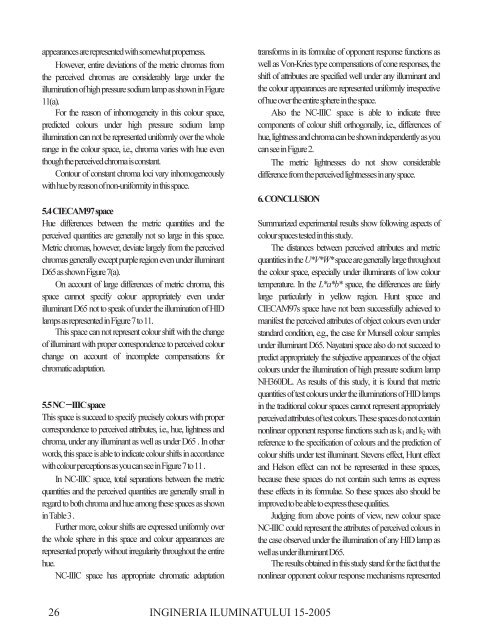Ingineria Iluminatului - Journal of Lighting Engineering - Prof. Florin ...
Ingineria Iluminatului - Journal of Lighting Engineering - Prof. Florin ...
Ingineria Iluminatului - Journal of Lighting Engineering - Prof. Florin ...
You also want an ePaper? Increase the reach of your titles
YUMPU automatically turns print PDFs into web optimized ePapers that Google loves.
appearances are represented with somewhat properness.<br />
However, entire deviations <strong>of</strong> the metric chromas from<br />
the perceived chromas are considerably large under the<br />
illumination <strong>of</strong> high pressure sodium lamp as shown in Figure<br />
11(a).<br />
For the reason <strong>of</strong> inhomogeneity in this colour space,<br />
predicted colours under high pressure sodium lamp<br />
illumination can not be represented uniformly over the whole<br />
range in the colour space, i.e., chroma varies with hue even<br />
though the perceived chroma is constant.<br />
Contour <strong>of</strong> constant chroma loci vary inhomogeneously<br />
with hue by reason <strong>of</strong> non-uniformity in this space.<br />
5.4 CIECAM97 space<br />
Hue differences between the metric quantities and the<br />
perceived quantities are generally not so large in this space.<br />
Metric chromas, however, deviate largely from the perceived<br />
chromas generally except purple region even under illuminant<br />
D65 as shown Figure 7(a).<br />
On account <strong>of</strong> large differences <strong>of</strong> metric chroma, this<br />
space cannot specify colour appropriately even under<br />
illuminant D65 not to speak <strong>of</strong> under the illumination <strong>of</strong> HID<br />
lamps as represented in Figure 7 to 11.<br />
This space can not represent colour shift with the change<br />
<strong>of</strong> illuminant with proper correspondence to perceived colour<br />
change on account <strong>of</strong> incomplete compensations for<br />
chromatic adaptation.<br />
5.5 NCIIIC space<br />
This space is succeed to specify precisely colours with proper<br />
correspondence to perceived attributes, i.e., hue, lightness and<br />
chroma, under any illuminant as well as under D65 . In other<br />
words, this space is able to indicate colour shifts in accordance<br />
with colour perceptions as you can see in Figure 7 to 11 .<br />
In NC-IIIC space, total separations between the metric<br />
quantities and the perceived quantities are generally small in<br />
regard to both chroma and hue among these spaces as shown<br />
in Table 3 .<br />
Further more, colour shifts are expressed uniformly over<br />
the whole sphere in this space and colour appearances are<br />
represented properly without irregularity throughout the entire<br />
hue.<br />
NC-IIIC space has appropriate chromatic adaptation<br />
26<br />
INGINERIA ILUMINATULUI 15-2005<br />
transforms in its formulae <strong>of</strong> opponent response functions as<br />
well as Von-Kries type compensations <strong>of</strong> cone responses, the<br />
shift <strong>of</strong> attributes are specified well under any illuminant and<br />
the colour appearances are represented uniformly irrespective<br />
<strong>of</strong> hue over the entire sphere in the space.<br />
Also the NC-IIIC space is able to indicate three<br />
components <strong>of</strong> colour shift orthogonally, i.e., differences <strong>of</strong><br />
hue, lightness and chroma can be shown independently as you<br />
can see in Figure 2.<br />
The metric lightnesses do not show considerable<br />
difference from the perceived lightnesses in any space.<br />
6. CONCLUSION<br />
Summarized experimental results show following aspects <strong>of</strong><br />
colour spaces tested in this study.<br />
The distances between perceived attributes and metric<br />
quantities in the U*V*W* space are generally large throughout<br />
the colour space, especially under illuminants <strong>of</strong> low colour<br />
temperature. In the L*a*b* space, the differences are fairly<br />
large particularly in yellow region. Hunt space and<br />
CIECAM97s space have not been successfully achieved to<br />
manifest the perceived attributes <strong>of</strong> object colours even under<br />
standard condition, e.g., the case for Munsell colour samples<br />
under illuminant D65. Nayatani space also do not succeed to<br />
predict appropriately the subjective appearances <strong>of</strong> the object<br />
colours under the illumination <strong>of</strong> high pressure sodium lamp<br />
NH360DL. As results <strong>of</strong> this study, it is found that metric<br />
quantities <strong>of</strong> test colours under the illuminations <strong>of</strong> HID lamps<br />
in the traditional colour spaces cannot represent appropriately<br />
perceived attributes <strong>of</strong> test colours. These spaces do not contain<br />
nonlinear opponent response functions such as k1 and k2 with<br />
reference to the specification <strong>of</strong> colours and the prediction <strong>of</strong><br />
colour shifts under test illuminant. Stevens effect, Hunt effect<br />
and Helson effect can not be represented in these spaces,<br />
because these spaces do not contain such terms as express<br />
these effects in its formulae. So these spaces also should be<br />
improved to be able to express these qualities.<br />
Judging from above points <strong>of</strong> view, new colour space<br />
NC-IIIC could represent the attributes <strong>of</strong> perceived colours in<br />
the case observed under the illumination <strong>of</strong> any HID lamp as<br />
well as under illuminant D65.<br />
The results obtained in this study stand for the fact that the<br />
nonlinear opponent colour response mechanisms represented
















